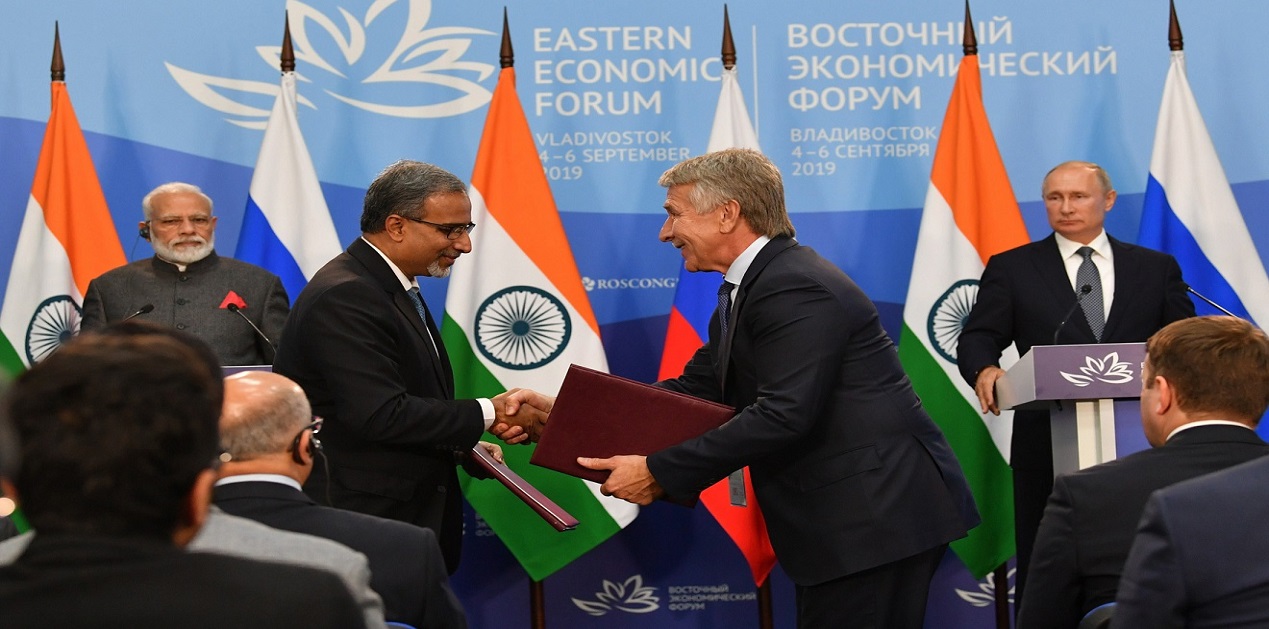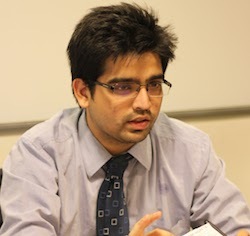Introduction
The Russian Foreign Minister, Sergei Lavrov, in his recent visit to India, attending the ‘Raisina Dialogue,’ opposed the Indo-Pacific concept, in New Delhi in January this year. In December 2019, the Russian Navy participated in a joint naval exercise with the Iranian and the Chinese Navy in the Gulf of Oman amid high tensions between Tehran and Washington.
The Russian opposition to Indo-Pacific, which it sees as a way of “containing China,”1 the joint naval exercises with China in the Gulf of Oman, which is a part of the Indo-Pacific concept, and China investing heavily into Russia especially in the energy sector, and with Russia putting its weight behind the Belt and Road Initiative leads to a question, is Russia looking towards China more seriously now than it did in the past as a reliable partner? With years of mutual distrust and suspicion between them, have both countries finally managed to come together? Furthermore, where are India-Russia relations headed in light of the growing closeness between Russia and China?
India-Russia at Vladivostok and after
In November 2019, two months after Prime Minister Narendra Modi announced the ‘Act Far East’ Policy, the Minister of Petroleum and Natural Gas and Minister of Steel, Shri Dharmendra Pradhan, met Russian representatives to discuss investments in the Far East region. Representatives from state and privately-owned companies of India met their counterparts to thaw out various issues of importing coal.2
The Vladivostok Summit in September 2019 saw leaders of India, Russia, and Japan together on the same stage where Prime Minister Modi, in line with President Putin’s plans for the development of Russia’s Far East, announced India’s “Act Far-East Policy.”3 The policy promises one billion USD line of credit from India to Russia.
Along with the line of credit, India and Russia also signed a host of agreements to increase cooperation on energy, technology, and military. Although there were no agreements signed between Russia and Japan, President Putin does hope for Japan to invest in the region.4 The line of credit by India could also push for one billion USD joint investment fund between the Japan Bank of International Cooperation, and the Russian Direct Investment Fund signed in August 2017.
India and Russia also signed a Memorandum of Understanding (MoU) for a maritime route between Vladivostok and Chennai,5 which one could argue was the highlight of the Indian Prime Minister’s visit. The proposed maritime route between India and Russia, as mentioned earlier, will pass through the South China Sea. The maritime route, while helping the trade between India and Russia, also presents an opportunity for India to play a more significant role through the “Act Far East” policy by bridging some gaps, if not all, between Russia and Japan and in extension, the U.S.
The line of credit by India in the Russian Far East and the MoU, as mentioned above, brings Russia one step closer to India’s view of ‘Indo-Pacific.’ The maritime route could also help in increasing crude imports from Russia as oil companies from India and Rosneft have signed an agreement that would enable the consortium of Indian companies to take stakes in the Vostok and Eastern Cluster oil projects in Arctic region. This new agreement will help India offset its dependence on OPEC countries as escalating tensions in the Middle East have led to an increase in oil prices.6
The meeting between Russian representatives and Dharmendra Pradhan was also an important step to understand and resolve the logistical issues faced by the Indian companies investing and importing coal from there. The Far East Investment and Export Agency (FEIEA), based out of Vladivostok, wants Indian companies to purchase stakes in Russian coal companies, especially those based out of the Russian Far East. This would encourage the Russian and the Indian government to work together to improve port facilities that can handle larger ships.7
Russia China relations facing stagflation?
Russia-China relations have reached a point of strategic partnership and interaction as their national interests converge.8 The two countries share similar views on conflicts in Libya, Syria, and also the nuclear issues of Iran and the Korean Peninsula. President Xi’s visit to the East Asia Forum in 2018 attested to the ever-growing relations between the two countries. By the end of 2019, Russia, China and Iran conducted a four-day joint military exercise in the Indian Ocean and the Gulf of Oman.9 However, relations growing and strengthening do not mean that there are no pressure points between the two countries.
An important question which daunts Russia-China relations is whether Russia will back China’s growth in Asia when it does not seem to have any intentions of cementing its relationship with Russia, whom it considers as a junior partner. On the economic side, the trade gap between the two countries is massive, a problem similar to that faced by India. On the geopolitical front, in the Korean Peninsula, the general perception is that Russia and China are on the same page, which might not be the case. In the pecking order of issues between the U.S and Russia, the Middle East and Europe are a priority.10 Russia would not want to get embroiled in a conflict in Northeast Asia. Russia-China relations are contingent on U.S actions against both countries. If the U.S decides to renegotiate with Russia on a variety of issues like Crimea, Iran, and if need be, North Korea then Russia might not play second fiddle to China.
For now, all seems well between Russia and China, but that might not be the case in the South China Sea. Russia has never had any straightforward policy on the South China Sea, and it does downplay the global significance of the conflict there as it sees it as a misinterpretation which helps the U.S jostle for power. However, now Rosneft is backing the Vietnamese government when heavily armed coast guard ships from Vietnam and China confront each other near the Vanguard Bank, which is 600 miles away from China and comes mostly within 200 miles of Vietnamese coastline making it legal for Vietnam to claim the Vanguard Bank. Vietnam has canceled the drillings as China threatened to attack Vietnamese positions in the Spratly Islands. 11
Rosneft’s involvement comes at a time when the Philippines has made a U-turn on its policy regarding the South China Sea and President Trump backing out of the Trans-Pacific Partnership, leaving little or no room for U.S intervention in case of a Chinese invasion of Spratly Islands. While the Russian government does not want to draw any attention to its cooperation with Vietnam (Rosneft is a Russian state-owned enterprise), one should not expect Russia to send a naval fleet to protect its interests.
Russian cooperation with Vietnam on resource extraction puts China in a tight spot as any harsh action, or statement could lead to China’s Belt and Road Initiative projects in Central Asia worth billions of dollars under stress as Russia considers Central Asia as its backyard. With Rosneft involved, it is anyone’s guess whether China will ramp up military drills in the region. 12 It is already using the People’s Armed Forces Militia which according to Article 36 of the 1984 Chinese Military Law and revised in 1998 “to undertake the duties related to preparations against war, defend the frontiers and maintain public order; and be always ready to join the armed forces to take part in war, resist aggression and defend the motherland,” calling the militia in action.
The stakes are higher for China now with Russia’s involvement in the South China Sea. It needs Russian support on various global issues. Russia’s involvement in the South China Sea might be positive for New Delhi, as it is also expanding its drilling operations for resources in cooperation with Vietnam in the region. India has advocated freedom of navigation and the right to access resources as per the international law, especially the United Nations Convention on the Law of the Sea (UNCLOS).13
It should not be overlooked that Russia still does not recognise the concept of Indo-Pacific and has also allowed Huawei, which is facing increasing resistance worldwide, in setting up Russia’s 5G infrastructure.14 Japan has already shown interest by pledging to “actively participate”15 in the Belt and Road Initiative and is trying to mend fences with China, and peace with Russia has been on Prime Minister’s Abe’s agenda since he returned to power in 2012. India and Japan have already started engaging in 2+2 dialogues, and further talks can discuss Russia-Japan relations as a related issue in future interactions.
Conclusion
‘Act Far-East’ policy does open a host of opportunities for India, Russia, and Japan as they aim to increase trade and balance relations with China. It also helps India to take a more considered stand regarding the South China Sea since the proposed maritime route with Russia goes through it. It also fulfills India’s view on ‘Indo-Pacific’ as “free and inclusive.” Initiatives taken, especially by India and Russia, could lead to a more robust economic relationship.
‘Act Far East’ allows India to look towards Russia as an alternative source of energy supplies as the situation in the Middle East is escalating with threats to essential oil trade routes. Rosneft’s involvement in the South China Sea allows India and Russia to collaborate in the region. The informal summit held in India promises some changes in India-China relations, but no progress has been made as of now on the boundary; economic and negotiations on the Regional Comprehensive Economic Partnership have not gone ahead.
India’s new economic diplomacy comes at a time when China’s Belt and Road Initiative is facing resistance in the U.S and elsewhere, while Chinese private and state-owned enterprises are being thoroughly verified. In these circumstances, a closer look at what India can do for Russia-Japan relations is fascinating, as both are important partners for New Delhi, and India has been concerned about the effects of a Chinese embrace of Russia.
References
- Roche, Elizabeth. “Russia Foreign Minister Sergei Lavrov Slams Concept of Indo-Pacific Region.” Livemint, January 15, 2020. https://www.livemint.com/news/world/russia-foreign-minister-sergei-lavrov-slams-concept-of-indo-pacific-region-11579101938207.html.
- ANI. “India's Coking Coal Imports from Russia to Increase Significantly: Dharmendra Pradhan.” Business Standard, November 26, 2019. https://www.business-standard.com/article/news-ani/india-s-coking-coal-imports-from-russia-to-increase-significantly-dharmendra-pradhan-119112700111_1.html.
- “PM Modi Launches 'Act Far East' Policy for Russia.” ANI, September 5, 2019. https://www.aninews.in/news/world/asia/pm-modi-launches-act-far-east-policy-for-russia20190906035535/.
- Grove, Thomas. “Putin's Pitch for Japan and India to Invest in Russia's Far East Falls Flat.” The Wall Street Journal. Dow Jones & Company, September 6, 2019. https://www.wsj.com/articles/putins-pitch-for-japan-and-india-to-invest-in-russias-far-east-falls-flat-11567766521.
- “India, Russia Sign Pact to Open Maritime Route Between Chennai and Vladivostok.” News18, September 4, 2019. https://www.news18.com/news/india/india-russia-sign-pact-to-open-maritime-route-between-chennai-and-vladivostok-2297059.html.
- “India Steps up Bid to Open Russian Oil Tap - Times of India.” The Times of India. Business, September 17, 2019. https://timesofindia.indiatimes.com/business/india-business/india-steps-up-bid-to-open-russian-oil-tap/articleshow/71176395.cms.
- “Indian Steel Firms Should Invest in Russian Coal Cos to Bring down Coal Price: FEIEA.” Business Today, November 27, 2019. https://www.businesstoday.in/current/economy-politics/indian-steel-firms-should-invest-in-russian-coal-cos-to-bring-down-coal-price-feiea/story/391146.html.
- Lukin, Alexander. “China and Russia: New BFFs Thanks to an Insecure US.” South China Morning Post, September 23, 2018. https://www.scmp.com/week-asia/geopolitics/article/2165255/china-and-russia-new-bffs-thanks-insecure-us.
- Westcott, Ben, and Hamdi Alkhshali. “China, Russia and Iran Hold Joint Naval Drills in Gulf of Oman.” CNN. Cable News Network, December 27, 2019. https://edition.cnn.com/2019/12/27/asia/china-russia-iran-military-drills-intl-hnk/index.html.
- “Second among Equals? Russia as China's ‘Junior Partner’ on the Korean Peninsula: NK News.” NK News - North Korea News, September 3, 2019. https://www.nknews.org/2019/09/second-among-equals-russia-as-chinas-junior-partner-on-the-korean-peninsula/.
- Murray, Bennett. “Vietnam's Strange Ally in Its Fight With China.” Foreign Policy. Foreign Policy, August 1, 2019. https://foreignpolicy.com/2019/08/01/vietnams-strange-ally-in-its-fight-with-china/.
- Poling, Gregory. “China's Hidden Navy.” Foreign Policy, June 25, 2019. https://foreignpolicy.com/2019/06/25/chinas-secret-navy-spratlys-southchinasea-chinesenavy-maritimemilitia/?fbclid=IwAR27uNheY2mvigmYJ1eZ_DAX1_z1H7ae02dGDG3v6OC9mtrRIKwz1q_yO9A.
- “Vietnam Briefs India about Chinese Action in South China Sea.” The Economic Times, July 29, 2019. https://economictimes.indiatimes.com/news/defence/vietnam-briefs-india-about-chinese-action-in-south-china-sea/articleshow/70436158.cms.
- Doffman, Zak. “Huawei Just Launched 5G In Russia With Putin's Support: 'Hello Splinternet'.” Forbes, September 2, 2019. https://www.forbes.com/sites/zakdoffman/2019/09/01/hello-splinternet-huawei-deploys-5g-in-russia-with-putins-support/.
- “Japan Pledges to Back BRI Project, Promote Economic Cooperation with China.” Business Standard. Business-Standard, October 26, 2018. https://www.business-standard.com/article/international/japan-pledges-to-back-bri-project-promote-economic-cooperation-with-china-118102601194_1.html.
(The paper is the author’s individual scholastic articulation. The author certifies that the article/paper is original in content, unpublished and it has not been submitted for publication/web upload elsewhere, and that the facts and figures quoted are duly referenced, as needed, and are believed to be correct). (The paper does not necessarily represent the organisational stance... More >>
Image Source: http://ddnews.gov.in/sites/default/files/20th%20India-Russia%20Summit%20talks.jpg











Post new comment